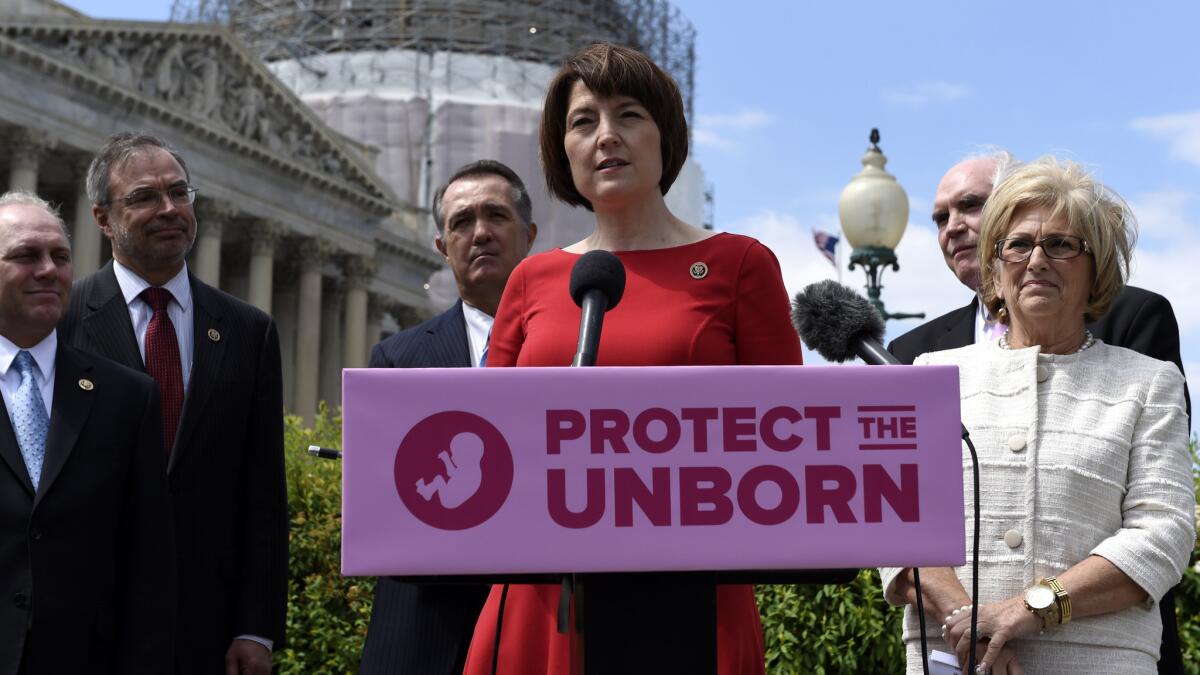Op-Ed: How to pass federal paid family leave and limit abortions

- Share via
The United States is not friendly to women who get pregnant. It has the worst record among advanced nations on mandatory maternity leave, and in most American cities, child-care costs now exceed a family’s rent. The Economic Policy Institute divided the nation into 618 budget areas; in 500 of them, child care for two kids costs more than housing.
Family leave programs and child-care support are energetically backed by liberals. Hillary Clinton just wrote an op-ed in the Washington Post pledging to provide incentives to improve the situation. Sen. Kirsten Gillibrand (D-N.Y.) has introduced federal legislation mandating paid family leave. If conservatives are wise, they will join in the effort. This is especially true for those who are antiabortion: They should want mothers to have the resources to help them keep their babies.
Most women who have abortions already have a child, and many millions report some combination of financial and work concerns as a significant factor in their decision to terminate a pregnancy. More than 40% of women who head families have incomes below the poverty line. If you are choosing between having a child and having the resources to support your family, is it any wonder that abortion becomes a desperate option?
At least some Republicans seem open to finding solutions to these problems — we might call them pro-life first, small-government second. Marco Rubio, for instance, proposed both increasing child tax credits and incentivizing businesses to provide paid family leave. Rep. Cathy McMorris Rodgers (R-Wash.), the highest-ranking Republican woman in Congress, also has proposed more work/parenting flexibility — including allowing private-sector workers to access “comp time” as paid family leave.
Paul Ryan, speaker of the House and de facto leader of the Republican Party, is in the process of evolving away from a “makers versus takers” approach to the role of government. He suggests generously funding social programs administrated by nimble local governments rather than the distant, one-size-fits-all federal bureaucracy. This approach puts him in a good position to express his Catholic faith — which insists that economic structures must be changed to permit mothers the opportunity to pursue their vocations at work and at home.
Programs that do help women as mothers and workers are sometimes criticized by conservatives as actually undermining that very goal. For instance, when mandatory unpaid family leave was passed by Congress in the 1990s, some believed it would lead to companies hiring fewer women. In reality, rates of hiring women increased. Would paid family leave be any different? It has worked out well for such economic powerhouses as Germany and the United Kingdom, and for California, which has had mandatory paid family leave for nearly a decade. A study by the Center for Economic Policy Research found that 96% of employers said the state law had been cost-neutral or saved them money.
Despite such evidence, these kinds of programs violate the extremist small-government orthodoxy of the Republican Party. Even if Democrats were to win the presidency this year, and a majority in the House and the Senate, the GOP would almost certainly filibuster bills that meaningfully addressed paid family leave and child-care costs.
That means that Democrats who want to see such bills pass need to come up with a carrot to get moderate Republicans on board. A nearly perfect one exists: the Pain-Capable Unborn Child Protection Act, which was passed by the House last year but filibustered by Senate Democrats.
The bill would ban elective abortions past the 20th week of pregnancy. The United States is extreme in allowing such abortions in the first place; it is one of only seven countries in the world that permit abortions beyond 20 weeks. Though there is legitimate debate among biologists about when a fetus can feel pain, the Pain-Capable Act’s 20-week ban is common-sense legislation that would catch up our abortion policy with France, Britain, Germany and most of the rest of the civilized world.
But Democrats are also trapped by party orthodoxy, and any action that curtails abortion rights is forbidden. Clinton used to emphasize that abortion should be “rare”; Democrats now parse her words, ready to attack if she’s seen to stray from a “no restrictions” stance.
If there is one thing this election cycle has shown, it is that the orthodoxies of both parties are being challenged. Indeed, a political realignment may be underway that will dramatically change the structures and assumptions of U.S. politics.
This political realignment also could free moderate Democrats and Republicans to dissent from their parties’ hidebound positions and work together to enact legislation that reflects what Americans want to see done. Most Americans — 81%, according to one poll, including 65% of Republicans — want help with child care and paid family leave. And a 2016 Marist poll found that 77% (including 79% of women and 71% of those who are antiabortion) say the law can protect both mother and baby.
Charles C. Camosy, an associate professor at Fordham University, is author of “Beyond the Abortion Wars” and a board member of Democrats for Life.
Message to Oklahoma: Give up on your unconstitutional abortion ban
When do fetuses feel pain? Question puts Utah abortion law and doctors at odds
Follow the Opinion section on Twitter @latimesopinionand Facebook
More to Read
A cure for the common opinion
Get thought-provoking perspectives with our weekly newsletter.
You may occasionally receive promotional content from the Los Angeles Times.










